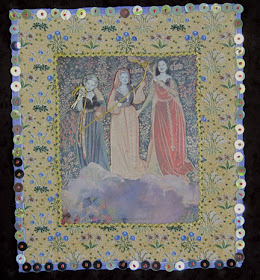The Three Fates or the Triumph of Death
Netherlands, Early 16th century
Victoria and Albert Museum
I've been reading about William Morris, the tapestries his workshops wove and what influenced Morris and his partners. I came across this 16th-century piece in the collection of London's V&A and was surprised to find a classical reference to textiles as a metaphor for life.
The three fates, Clotho, Lachesis and Atropos, are based on Greek mythology. They control human life. Clotho, on the left with her spindle, spins the thread of life. Lachesis on the right draws lots on how long one will live. Atropos in the center cuts the thread.....Fate.
The tapestry in the Victoria and Albert Museum, a fragment from a larger piece, is based on an Italian poem from the 14th century. Petrarch's poem The Triumphs contains six allegories: the Triumph of Death (the tapestry at the top of the page) Triumph of Love, the Triumph of Chastity, the Triumph of Fame (below), the Triumph of Time and the Triumph of Eternity.
The Triumph of Fame over Death
William Morris and his friends were undoubtedly familiar with these tapestries, which seem to be a sort of scissors/paper/stone analogy---one thing triumphs over another.
It's always something.
Several of the Morris prints, such as Daisy (1864), feature florals drawn from the old tapestries. The flowers and the repeat are in the backgrounds of the woven pieces.
But....back to Clotho and Atropos, one who spins the thread, the other who cuts it.
Inspired by the original tapestry, Morris's daisy print (I found a reproduction) and my Photoshopping program, I created a Three Fates embroidered tapestry.
Three Fates, Barbara Brackman
2009
Embroidered and altered photography on cotton
A detail of Atropos and Lachesis, otherwise known as Zsa-Zsa and Eva.
Now I have fate hanging over my sewing machine.
See more about the Triumph of Death tapestry by clicking here:
http://www.vam.ac.uk/images/image/55368-popup.html






























































